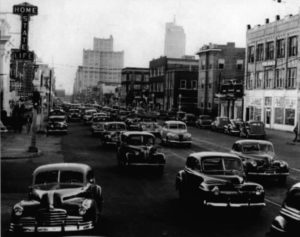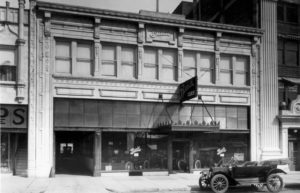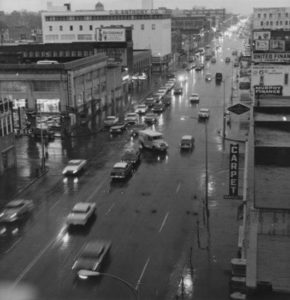By 1911 the State of Oklahoma was only three years old. Even then, savvy entrepreneurs saw the city’s potential for growth, bringing car dealers to a strip of North Broadway. While the area fell into a state of decline in the 70s and 80s, its potential has been rediscovered by a new breed of driven locals, jump-starting revitalization and restoration efforts, transforming Automobile Alley into Oklahoma City’s most coveted real estate. 
The area is known today as Automobile Alley has a very diverse history. The main core, Broadway Avenue, was part of Oklahoma City from the very beginning. It was the primary north-south street of the growing new town. The first few blocks north of Grand Boulevard (now Sheridan) were prime commercial lots. But as you travel further north, the area became residential property. Consequently, the core of Automobile Alley started out as pioneering homes.
The Automobile Alley historic district was developed primarily in the 1920’s, as a commercial district just north of downtown Oklahoma City. Broadway Avenue, with a 100 foot right-of-way, had been platted as the widest north-south street in the 1889 townsite plat, which went as far north as Northwest Fourth; this width was continued with subsequent plats.
Over time, frame houses constructed in the 1890’s and 1900’s were replaced with commercial uses and brick buildings. Rumor has it that the street was just wide enough to turn a team full of horses and a wagon around, but wagons were becoming less and less common along this major thoroughfare.
In the late 1910’s and early 1920’s many of the residential properties along North Broadway Avenue were giving way to automobile related businesses, hotels, and apartment buildings. The majority of these buildings were of a commercial style and the earliest ones were often constructed of brick. There were automobile dealerships and service companies. The nature of this type of business led to the typical construction we still see along Broadway; wide bays with large expanses of glass; no more than two or three floors. These buildings had large garage doors, which allowed for easy accessibility. In fact, by the 1920’s, it was reported that 52 of Oklahoma City’s first 76 auto dealerships were located along Broadway.
 Those buildings, which were not structurally brick, were usually of concrete construction with a brick veneer. Concrete or cast stones ornaments began to appear on buildings and was much more mechanical than typical ornamentation. In the first decade of the twentieth century, much of the ornamentation was related to plant materials or was taken from classical architectural elements. As mass production began to take over the market, the elements of a building often appeared as parts of a car or a machine. Even the brickwork patterns changed so that they appeared more mechanical. The Magnolia Building has a magnolia blossom, while others have what look like commercial structures related to the automotive industry, the areas to the east along the railroad were being used for warehousing and manufacturing. Direct access to the railroad provided many companies the opportunity to build right next to the tracks. These buildings were often taller (three to five floors) to provide as much interior working space as possible adjacent to the tracks. Again, construction was brick or concrete, and since the majority of these buildings were constructed prior to the automobile boom, they were more classical in nature.
Those buildings, which were not structurally brick, were usually of concrete construction with a brick veneer. Concrete or cast stones ornaments began to appear on buildings and was much more mechanical than typical ornamentation. In the first decade of the twentieth century, much of the ornamentation was related to plant materials or was taken from classical architectural elements. As mass production began to take over the market, the elements of a building often appeared as parts of a car or a machine. Even the brickwork patterns changed so that they appeared more mechanical. The Magnolia Building has a magnolia blossom, while others have what look like commercial structures related to the automotive industry, the areas to the east along the railroad were being used for warehousing and manufacturing. Direct access to the railroad provided many companies the opportunity to build right next to the tracks. These buildings were often taller (three to five floors) to provide as much interior working space as possible adjacent to the tracks. Again, construction was brick or concrete, and since the majority of these buildings were constructed prior to the automobile boom, they were more classical in nature.
 Occasional arched windows, engaged columns and pilasters, and traditional brickwork patterns were common. Since these building were not used for retail purposes, large storefront windows were not necessary. More commonly, a basement was needed to increase the square footage and the first floor was often a few steps above ground level. The upper floors would have many windows for light and ventilation. As these buildings were older, most these windows were double hung.
Occasional arched windows, engaged columns and pilasters, and traditional brickwork patterns were common. Since these building were not used for retail purposes, large storefront windows were not necessary. More commonly, a basement was needed to increase the square footage and the first floor was often a few steps above ground level. The upper floors would have many windows for light and ventilation. As these buildings were older, most these windows were double hung.
The Automobile Alley district extends east beyond the tracks of the A.T.&S.F. railroad. This area initially was not a developed area of Oklahoma City. But as the city began to expand, the area east of the tracks became one of the city’s prime residential areas, the Harrison-Walnut area. Many of the city’s earliest entrepreneurs lived in Victorian homes and apartment buildings here.
To view Automobile Alley’s Guidelines for the Next Century, click here.
